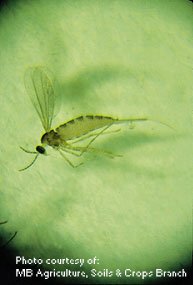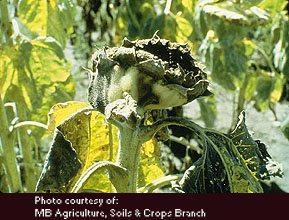Sunflower Midge

Figure 1

Figure 2
Midge larvae can affect the growth of sunflower heads. Heavily-damaged heads are gnarled and cupped inwardly, producing few seeds.
Host Crops
Sunflowers
Biology
The tiny, tan-coloured, adult sunflower midge (Contarinia schulzi) is only about 2 mm (1/8 in.) long (Figure 1). Eggs are laid individually or in groups in depressions between the bracts of the sunflower bud. The featureless midge larva is tiny, being only about 3 mm (1/8 in.) long when full-grown. The newly emerged larvae move to the bases of developing seeds or bracts. They use their rasping mouthparts to feed on the plant tissues in these locations.
Mature larvae drop from the head and burrow into the soil. If conditions are favourable, they pupate and emerge the same season. Otherwise, they remain in the soil and overwinter as larvae in cocoons or, in some cases, as pupae. Usually, the larvae pupate in the spring. The adults start to emerge in late June. The adult midges only live for two to three days and are difficult to find in the field.
| May | June | July | August | September |
| Overwintering larvae pupate | Adult midges emerge, egg laying begins | Larval feeding | Larvae move into soil | Overwinter as larvae or pupae |
Scouting Techniques
Although damage may be severe, it is usually sporadic and localized. Damage to heads (Figure 2) is usually restricted to field margins but, in severe infestations, damage is present throughout the field.
When monitoring sunflower heads, look for the midge larvae in the flower head, scarred bracts, and twisted or gnarled flowers. The larvae may be found at the base of the bracts or feeding in the flower, at the base of the florets. A 10x magnifier helps in locating the tiny larvae.
Economic Thresholds
No threshold has been established for this pest in either oil type or confection sunflowers.
Control Tips
Delayed planting (until late May) may avoid the first major emergence of the overwintering population. However, later infestations can still be severe.
Some commercial hybrids are tolerant or resistant to the sunflower midge. Consult your provincial agricultural representative for information on the most resistant varieties.
Insecticides do not work well against this pest. They provide inconsistent and inadequate control of the adults and larvae. Because the larvae crawl into the bud soon after hatching, they are protected from foliar applications. Insecticides can control the sunflower midge only if they are applied to the foliage just before the adults emerge. However, because this emergence cannot be accurately predicted, insecticide applications are ineffective.

